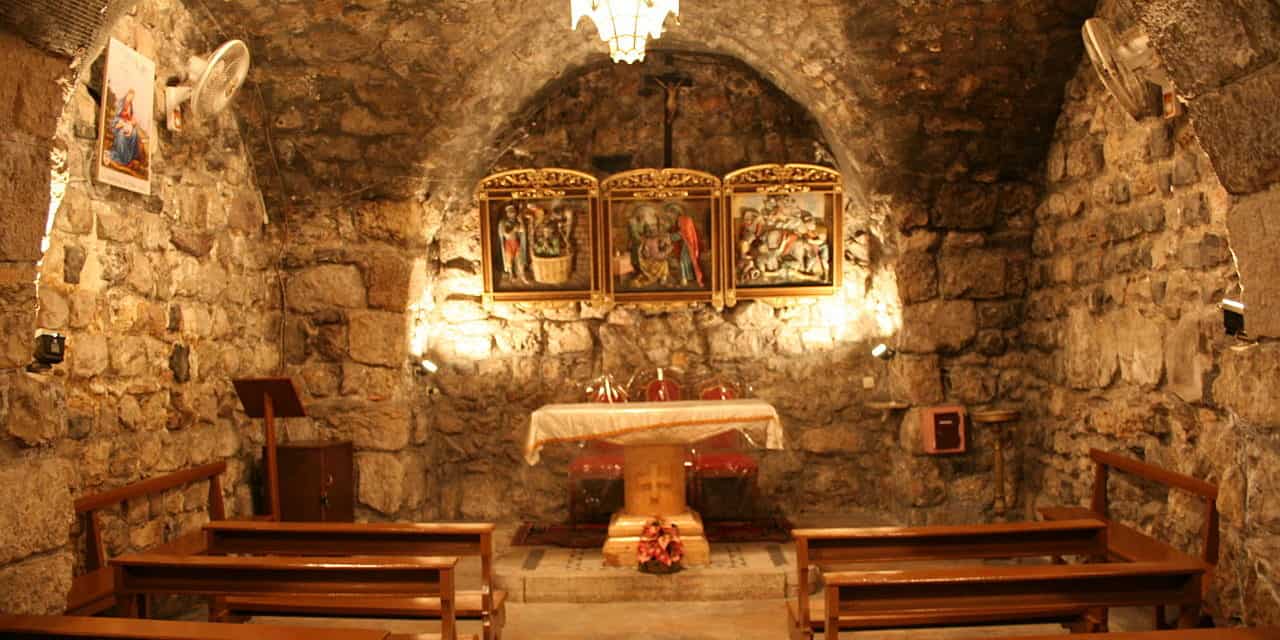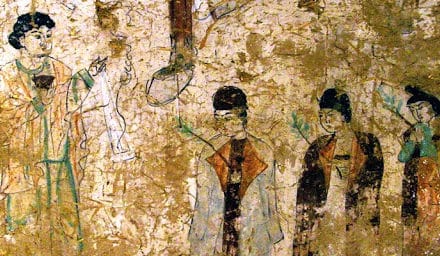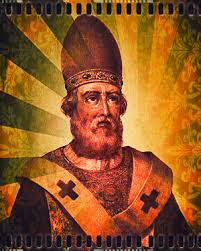This episode of is titled, “How Close?”
One of the things modern Christians want to know is how close their church is to the primitive church of the 1st & 2nd Cs. Congregations and entire movements claim their particular expression of the Faith is closest to the original. So, what were early church services like? Where did they meet and what did they do?
Until the end of the 2nd C, Christians met for services in private homes, deserted buildings, caves, near graves of martyrs, & in catacombs. Catacombs were a common feature of many cities of the Empire. Besides their primary use as burial places, they were frequent hiding places for refugees, smugglers, and groups that wanted to meet away from the watchful eye of authorities. Rome’s catacombs were a massive subterranean tunnel system.
Jesus’ Followers used these places to meet because during these first centuries they were mostly drawn from the poorer classes of society & couldn’t afford a unique place devoted solely to worship. Their meetings were often banned, requiring they meet in secret. Another reason they tended to meet in locations away from the busy streets was because of the prevalence of lewd graffiti, ubiquitous in Roman cities. Graffiti isn’t a recent phenomenon; it has a long & storied history. Much of the graffiti encountered in Rome’s streets was political cartoons & commentary. But it was also bawdy and offensive to the sensitive morality of many Christians. So they looked for places outside the city to meet where pornography wasn’t scrawled on nearby walls.
One of the points made by the Church Fathers knowns as the Apologists, who answered the attacks of pagan critics was that Christians had neither temples nor altars because their religion was fundamentally spiritual and needed no place for ritual. Their critics jumped on this lack of religious place as evidence of the silliness of the Faith. After all, if God was worthy of worship, they reasoned, wouldn’t He require a building? Origin replied eloquently to this attack by saying Christians were living statues of the Holy Spirit – and that each human being was immensely more glorious than any temple made of mere stone. In a significant remark from Justin Martyr to a Roman governor, he wrote that “Christians assemble wherever it’s convenient, because their God is not like the gods of the heathen, enclosed in space, but is invisibly present everywhere.”
The homes early Christian met in had to have been large enough to accommodate a congregation. Based on what we now know about Roman architecture, such a home had a dining hall providing the best place to assemble. In the center of the long wall an elevated chair was set where the leader of the service led the assembled. Near him was a simple table upon which the elements of the Lord’s Supper were set. If they met in catacombs, a similar arrangement was made.
The Early Church Father Tertullian was one of the first to speak of “going to church;” using the word “church” for the place where a congregation met. Clement of Alexandria who lived about the same time, makes reference in his writings to how the word “church” meant both the people & the place they met.
About AD 230, the Roman Emperor Alexander Severus granted the followers of Jesus the right to have a building in Rome dedicated exclusively to worship. What’s interesting about this is that the loudest hew & cry against the church using its own building came from the tavern-keepers. The church was going to be located in a place rife with taverns and it meant some of them would have to be relocated to build the church. They also didn’t like the moral influence a church would bring.
This Imperial permission to build a church greatly encouraged other cities around the Empire to allow the fast-growing Christian sect to build more facilities dedicated exclusively to holding services. The persecutions of Decius & Diocletian at the end of the 3rd & beginning of the 4th C put a hold on such construction, and saw many of the buildings that had been built either torn down or converted to pagan use. Diocletian began his persecution in 303 by tearing down the huge church in his capital at Nicomedia. Yet by the beginning of the 4th C, Rome had some 40 churches!
While we know the building of churches took place in the last half of the 3rd C, we have little idea of what they looked like. That changes with the acceptance of Christianity by the Emperor Constantine. It’s reasonable to assume the earlier churches were in some way similar to the basilicas Constantine built for both civil & religious use.
They were rectangular with a proportion of 3 by 4. A semi-circular niche lay at the narrow end opposite the main door. The niche was the place where the elevated seat was set for the lead pastor, AKA the bishop. Ranging down the aisles of the main hall was a colonnade where people gathered in smaller groups, or if the central floor of the nave was full, they could spill into during the service.
Christians met to hold their weekly service on Sunday, which they called “The Lord’s Day” because it’s the day of the week Jesus rose. The first Christians were Jews, who zealously observed the Sabbath on Saturday, but also gathered on Sunday, the first day of the week, so a work-day, early in the morning before work began. As the Church grew in the Gentile world, the church gathered only on Sunday. This is confirmed by ample evidence in the writings of Ignatius, Justin Martyr & the Didache.
Those first Gentile Believers didn’t celebrate Sunday as a kind of Christian Sabbath, ceasing from work as they did later. That would have been impossible for the slaves of heathen masters who made up a large proportion of the Church in the early decades. It wasn’t until the time of Constantine that engaging in labor on The Lord’s Day was frowned on. What also was put under the ban was theatrical entertainments. Greek & Roman theaters were more often than not, places of grotesque lewdness, not fitting for the moral sensitivity of believers.
In light of the often contentious debates marking modern believers, it’s instructive that the Church Fathers never saw the Christian observance of Sunday as a continuation of the Jewish Sabbath. Sunday wasn’t regarded as a Christian version of obeying the 4th Commandment’s call to “Keep the Sabbath Day.” The Fathers DO however recognize as implicit in the teaching of Scripture the call to regular worship, and that meant specifying a day each week for gathering to worship. Ignatius, who we’ve already seen as one of the most important of the Church Fathers, specifically contrasts the Jewish Sabbath with the Christian Sunday – saying that the prior is replaced by the later. But he makes pains to point out that making Sunday the Lord’s Day is not a fulfillment of the 4th Commandment. Rather, Ignatius sees the 4th Commandment as fulfilled in the perpetual rest believers have in the death & resurrection of Christ
These weren’t the only days of the week Christians practiced specific actions as evidence of their faith. While Sunday celebrated the resurrection, Wednesdays & Fridays commemorated Jesus’ suffering & death. This was memorialized by partial fasts, till 3 PM.
When Christians gathered on Sunday, there were certain things they did that constituted a service. This order of service evolved over time but became a fairly uniform practice by the 4th C throughout the churches. In the earliest years, a portion of the OT Scripture was read and someone with skill at public speaking would explain & apply the passage. Several short such passages & homilies could be given, depending on how may skilled speakers there were. It didn’t take long before one of the elders was recognized as the God-ordained teacher & leader of the congregation and was designated as their pastor-bishop.
Soon the documents of the NT & writings of the Apostolic Fathers were also read & studied.
With the emergence of the bishop as the leader of a local church, the sermon became one of the primary elements in the service. We have the record of an ancient sermon delivered by an anonymous pastor around AD 140. It’s not very good, but the way he closes the message is interesting for the simple reason that it doesn’t sound all that different from what tens of thousands of pastors say in their churches every week to this day! It ends thus …
“To the only God invisible, the Father of Truth, who sent forth unto us the Savior & Prince of immortality, through whom also He made manifest unto us the truth and the heavenly life, to Him be the glory forever & ever. Amen.”
Prayer was a major part of church services. Since many of the letters of the Apostolic Fathers include their prayers, we get a sense of what prayers were like in the churches of this time. What’s remarkable about them is how filled with Scripture they are. Their prayers were based on the revelation of God in the Bible and are appeals to His promises. They prayed for the suffering, the needy, travelers, prisoners; they pleaded with God to save the lost, confessed their sins, and asked for the preservation of their unity. Also notable is the emphasis on praying for the Emperor, for governors and all those in authority in the civil realm. These prayers weren’t anathemas, that is – calls for divine displeasure to fall in fiery bolts on pagan heads. They were prayers for blessing, peace, wisdom and courage.
When they prayed, they stood, with hands stretched out toward heaven.
The Church also sang – a lot! Their songbook was the Psalms. Besides the Psalter, they developed hymns; songs expressing Christian belief & theology. The man or woman who finds rote memorization difficult will often easily pick up a song & be able to sing several verses from memory. Singing was a way to both worship & learn theology.
For a period of about 350 years, from the mid-2nd C to the close of the 5th, some churches divided their service into 2 parts. The first was open to all & was aimed at educating candidates for baptism. There was singing, prayer & a sermon. Then those who had NOT been baptized were dismissed and the doors were closed. Those members who’d been baptized would then engage in more prayer, singing, and finally, the celebration of Communion. Participation at the Lord’s Table was prohibited to the unbaptized.
Dividing the service into 2 parts was a minority view refuted by some Church Fathers. Justin Martyr, in his first defense of the Faith to the Emperor marks no distinction for those who could celebrate Communion. The growing hierarchical spirit that took root in the Church from the mid-2nd C on & advanced so strongly by Ignatius, seems to also have encouraged the dualism that developed in the Church; a dualism that divided the congregation between candidates & the elect; with baptism being the dividing line.
Another factor that encouraged the development of a second, closed & secretive part of the service was the challenge presented by the Gnostics. The second part of the service, closed as it was to initiates, began to be used in some churches as a time for instruction in what came to be considered deeper spiritual lessons. The Gnostics had their “secret knowledge” which proved so appealing to many. So, some churches developed their own brand of esoteric knowledge – things that were thought to be appropriate only for those who’d been baptized & could regularly partake of Communion. Those who advocated this secretive aspect of church life defended it by quoting Matthew 7 where Jesus warned His followers against giving what was holy to the dogs & casting pearls before swine. They claimed it’s what the Apostles meant when they wrote of the distinction of “milk for babes” but “meat for those of full-age” & the difference between those who were “carnal” & the “spiritual.”
Some historians hold that one reason for the secretive nature of some aspect of church meetings was the simple & practical need for modesty. Primitive baptism was full-immersion. Since Christians often went directly from a service to work, they had to remove their clothing to be baptized. This meant the need for privacy with men & women being separated.
By the 6th C, the challenge of Gnosticism was past & the church was no longer being persecuted. With the pressure off, baptism, while still important, was endowed with less significance than it had possessed during the era of persecution when the problem of the lapsed framed so much debate. For all these reasons, the division of the service into 2 parts diminished until by the end of the 6th C the vast majority of churches had just one service, though unbaptized members were told not to partake of the Lord’s Table.
Communion was the central event of each service. In that time, the Lord’s Table was called, “The Eucharist” a Greek word meaning thanksgiving. This was the climax & conclusion of the church service. I quote from Justin Martyr’s description; …
After the prayers we greet one another with a brotherly kiss. Then bread & a cup with water & wine are handed to the bishop of the brethren. He receives them, and offers praise, glory, and thanks to the Father of all, through the name of the Son and the Holy Spirit, for these His gifts. When he has ended the prayers and thanksgiving, the whole congregation responds; ‘Amen.’ … Upon this the deacons, as we call them, give to each of those present some of the blessed bread, and of the wine mingled with water, and carry it to the absent in their dwellings.
Communion was celebrated at least weekly. There’s evidence in some places it was celebrated daily as Christians gathered early in the morning to pray, sing a song or 2, take communion then disperse. They based this practice of daily communion on that part of the Lord’s Prayer which said, “Give us this day, our daily bread.”
In the earliest days of the church, they met on Sunday evening to share a common meal called the Agape, the Love Feast. The last part of the meal, which we’d call the dessert, was the Lord’s Table. For them, it wasn’t a dessert of sweets so much as a spiritual sweetness in communing with the Lord and one another. A kiss of fellowship was a part of this. Men would kiss other men on the cheek as would the women to one another. This kiss was a dear & holy mark of the celebration of their spiritual unity & familial relationship.
It also became the ground for abuse as wine was a part of the common meal & some drank a little more than they ought. Loosened inhibitions moved some to a less than holy application of the kiss when the pattern of male to male moved to male to female “fellowship.” The Apostle Paul addresses the abuse of the Agape in writing to the Corinthians & in other letters reminds the churched to keep the kiss HOLY!
The bread used for Communion was regular bread. The wine was mixed with water. The deacons handed each person a piece & they all drank from a common cup. When they ate, they stood. When the service was finished, the deacons took the elements to the homes of shut-ins & those in prison. Many of the Christians of North Africa took some of the communion bread home with them and used it for a private daily communion.
As we end this episode, I wanted to express my appreciation to all who’ve reviewed the podcast on iTunes.
For those who haven’t yet, I invite you to head to the Facebook page to give the podcast a “Like” and leave a comment on where you live. You can find it at CS – History of the Christian Church.






Love your series! This is my second listen-through. Just a note though, Justin Martyr *did* specifically say that only believers were allowed to participate in communion in the first apology. I believe the part you’re referring to in saying that he made no distinction was a simple summary. But in the chapter before (66), he mentions communion: “of which no one is allowed to partake but the man who believes that the things which we teach are true, and who has been washed with the washing that is for the remission of sins, and unto regeneration, and who is so living as Christ has enjoined.”
It’s no big deal, just thought I’d mention it 🙂 Again, I love this series, and I’m really enjoying your sermons on James.
David,
Thanks for the kind words.
And much appreciation for the correction.
I just added a note to the script for future reference.
Lance